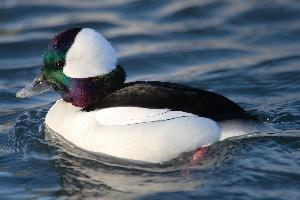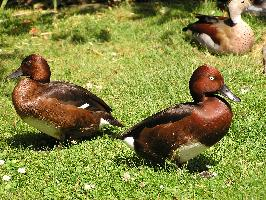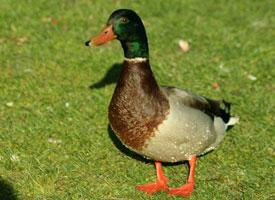
Váhy a míry
| Délka | od 32 do 39 cm |
|---|
Popis zvířete
The Bufflehead (Bucephala albeola) is a small North American sea duck, belonging to the family Anatidae. This charming bird is easily identifiable and much admired for its distinctive appearance and fascinating behaviors. The name "Bufflehead" is derived from "buffalo head," a nod to the male's large, bulbous head shape, especially noticeable when the bird puffs out its feathers during courtship displays or when alert.Adult males are striking with their iridescent black and white plumage. The back of the body is mostly black, contrasting sharply with the predominantly white sides and belly. The male's head is adorned with a large, white patch that starts at the base of the bill, extends over the back of the head, and is framed by iridescent green and purple hues, depending on the light. This bold coloration makes the male bufflehead one of the more easily identified ducks, even from a distance.
Females and juveniles are more subdued in color. They have a dark brown body, with a smaller white cheek patch, and a darker bill compared to the males. Despite their less flashy appearance, female buffleheads are still quite striking, with their own understated elegance.
Buffleheads are among the smallest diving ducks in North America, with a body length typically ranging from 32 to 40 centimeters (13 to 16 inches) and a wingspan of approximately 55 centimeters (21.5 inches). Their compact size and swift flying ability make them agile fliers, capable of quick, darting movements that are a delight to observe.
These ducks are migratory, breeding in the boreal forests of Canada and Alaska, where they nest in cavities of trees, often those excavated by Northern Flickers or Pileated Woodpeckers. Unlike many other duck species, buffleheads have a strong fidelity to their nesting sites, often returning to the same cavity year after year. This site fidelity, combined with their dependence on specific nesting habitat, highlights the importance of conserving mature boreal forests for their survival.
During the winter months, buffleheads migrate to the coastal waters of the United States, stretching from the Pacific Northwest down to the Gulf of Mexico, and along the Atlantic coast. Here, they can be found in sheltered bays, estuaries, and occasionally on freshwater lakes and ponds. Their diet primarily consists of aquatic invertebrates, which they obtain by diving underwater. Remarkably efficient divers, buffleheads can disappear beneath the surface in a blink, reappearing moments later with their catch.
Socially, buffleheads are often seen in small flocks during migration and winter, though they are not as gregarious as some other duck species. Their breeding season is characterized by elaborate courtship displays, where males perform a series of movements including head-bobbing, wing-flapping, and vocalizations to attract females.
Despite facing threats such as habitat loss and climate change, the bufflehead population remains stable, largely due to their adaptability and the conservation of critical habitats. Their presence continues to be a joy and a spectacle for bird watchers and nature enthusiasts across North America.
In summary, the Bufflehead is a small, distinctive duck known for its striking plumage, remarkable diving ability, and strong site fidelity. This charming bird's life cycle, from its specialized nesting habits in the boreal forests to its wintering in coastal waters, showcases the intricate connections within ecosystems and underscores the importance of habitat conservation.
Podobná zvířata
Nové fotografie zvířat
Top 10 zvířat
- Dolphin gull (Leucophaeus scoresbii)
- Diana monkey (Cercopithecus diana)
- Moustached guenon (Cercopithecus cephus)
- Galápagos tortoise (Geochelone nigra complex)
- Russian tortoise (Testudo horsfieldii)
- Australian box jelly (Chironex fleckeri)
- Common house mosquito (Culex pipiens)
- Colossal squid (Mesonychoteuthis hamiltoni)
- Japanese macaque (Macaca fuscata)
- Greek tortoise (Testudo graeca)


